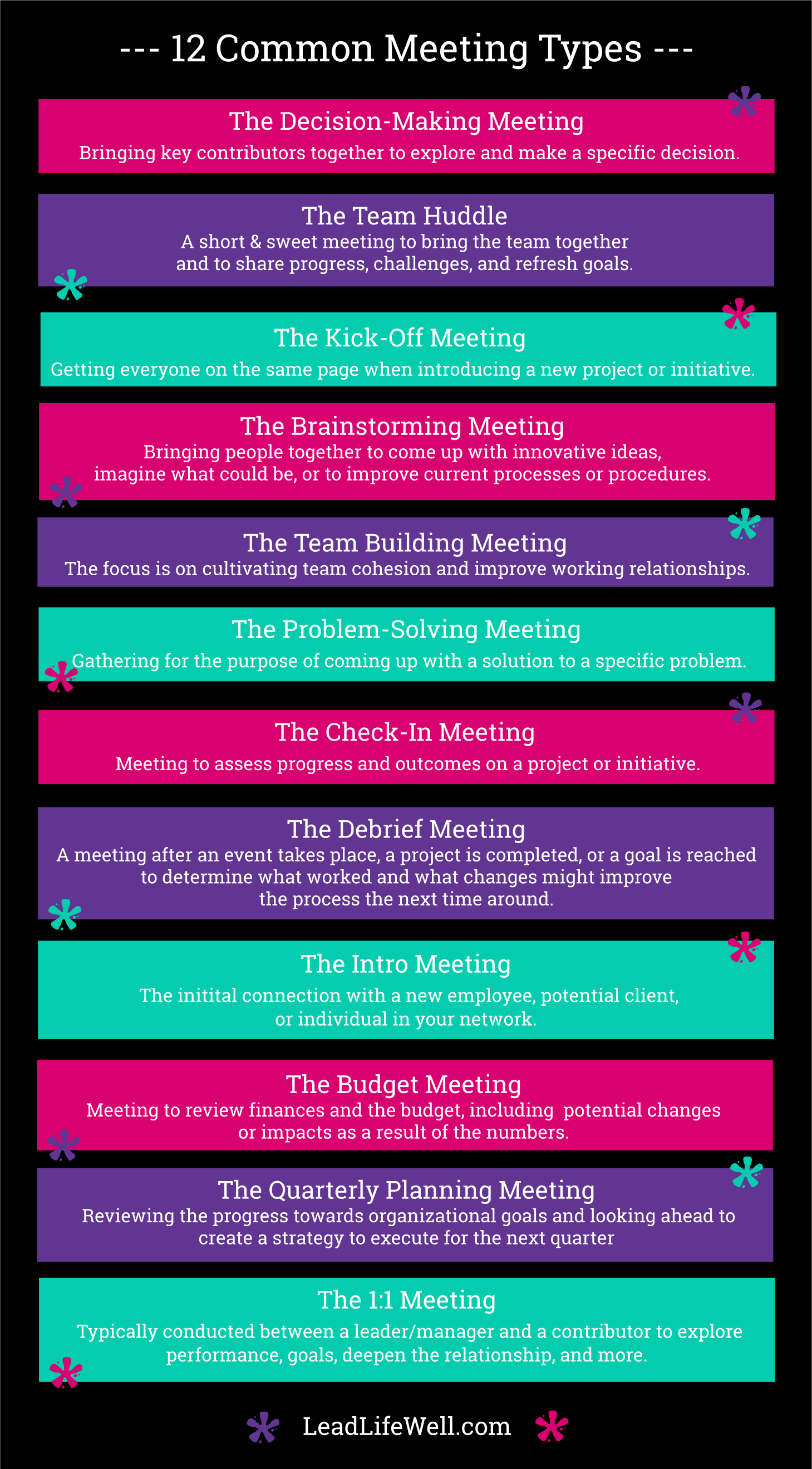Make Your Meetings Worth Their Time!

eting? What flashes through your mind when you hear the word meeting? A sense of excitement? Dread? The urge to run?
The mindset you bring into meetings matters whether you are the leader or a participant! Trust me, your feelings of excitement, dread, or something else shine through.
While the burden of having successful meetings lies on the leader, as a participant, you also have a responsibility. When you show up, are fully engaged, and are positive, you have the opportunity to make a ho hum meeting a highly productive meeting. Your choice!
As the leader, if you manage meetings well, they have the opportunity to enhance morale, productivity, and efficiency in your organization. Done poorly, you get the opposite effect.
What Kind of Meeting?
Meetings take place for all sorts of reasons, but here are 12 of the most common kinds meetings:
Your success as a leader or a manager and the success of your organization is impacted by the success of your meetings. In fact, your meetings are currently fueling morale – either positively or negatively. And your meetings are detracting from your productivity or they are enhancing productivity depending on the way you conduct your meetings.
3 Major Meeting Mistakes
Before I share some specific tips to help you improve the quality of your meetings, I want to ensure that you are not making any of these counterproductive mistakes:
- Trying to Accomplish Too Much
Perhaps that foreboding feelings sets in when another meeting is scheduled in your organization because the meetings go on and on and feel like a waste of time. As a result, you refrain from scheduling meetings but that only compounds the problems. Then when you do hold a meeting, you try to do too much and nothing gets the focused attention it really needs.
It’s better to have more frequent and focused meetings that actually accomplish something then those never-ending ones.
- Having Regular Meetings Just to Have Them
Every time you conduct a meeting that’s a waste of time, it undermines your future meetings. Of course, the flip is true too! If your meetings are enjoyable, efficient, and productive, your people won’t want to miss them!
- Overlooking Your Other Options!
Some situations just don’t warrant a meeting! There are many other ways to communicate information, track progress, and get your people unified in purpose. Technology is your friend! Consider conveying information or asking questions via email, Slack, Monday.com, Confluence, Smartsheet, or Mural. Why not have processes in place that maximizes time?
Get in the habit of asking “is this a topic that could be handled in an alternate way”? Could it be handled in one of the methods suggested above or maybe virtually?
8 Tips to Make Your Meetings GREAT!
1. Know Your Purpose
What is the primary focus of the meeting and what outcome are you seeking? Remember, every time you have add an additional focus to the agenda you dilute your energies.
2. Have An Agenda
Your agenda should include…
-
-
- The purpose of the meeting,
- Who will be a part of the meeting and what they should come prepared to discuss or share.
- The flow of the meeting, including how much time you plan to spend on each aspect of the meeting. Don’t forget to include time for review, questions, updates, and time to clarify next steps.
-
While frequently overlooked, your meetings will be made up of individuals with different personalities, thinking preferences, and strengths. Be sure that you are appealing to the people who will be there. It’s natural to plan a meeting that would suit who you are, but it takes an intentional effort to create a meeting that’s works for those who aren’t like you!
As you are planning your meeting, consider taking a walk around the brain so that you naturally are presenting information in a whole brain way.
And consider the personalities that will be in the room and communicate accordingly.
3. Invite the Right People
Be sure that you are not wasting people’s time by inviting them to a meeting they don’t really need to be a part of. The individuals who are requested to be at the meeting should each play an active role.
Send out a calendar invite along with the agenda so that people are able to confirm/decline that they will be there and arrive prepared. Simple systems like this are fabulous time savers!
4. Begin and End in a Timely Manner
Get in the habit of beginning and ending on time. Starting when you said you would lets people know that you won’t wait for them to arrive. And that the meeting has a definite ending time.
Consider holding shorter, but more frequent meetings that are more focused, rather than longer, more drawn out meetings.
Another idea to consider is holding brief “stand-up” meetings, or if you are meeting with one or two other individuals why not walk and talk? Meetings like this are energizing and good for you too!
5. Create a Safe Space
You want your meetings to feel safe and comfortable so the participants are able to be creative and contribute their thoughts and ideas without judgment. As the leader or manager, you set the tone. If sticky situations arise in the meetings, resist the urge to reprimand publicly, and address those situations later.
What ground rules would create the safe environment you desire?
6. Make Your Meetings Enjoyable
Let’s face it, most meetings are the same old thing. The more enjoyable your meetings are the more effective they will be not to mention pleasant and inspiring too. I promise that won’t just happen. You’ll have to slow down and do some thinking about what would freshen up your meetings.
Here are a few suggestions to get your creative juices flowing:
-
-
- Switch up the location – new scenery is amazing!
- Include some humor
- Celebrate successes – so often meetings focus on what’s not working – highlighting what is motivating!
- Surprise your people with a treat like muffins and/or fancy coffee
- Change up the time
- Walk & talk
-
7. Assign Roles
When people have a role to play, they are naturally more engaged. Consider assigning roles for each person to play in the agenda when it’s sent out. Who will be the…
-
-
- Meeting facilitator?
- Time keeper who ensures you stick to the timeline?
- Note taker? Someone who captures highlights, possible future meeting topics to be discussed at another time, and any other noteworthy bits of information that surfaces.
- Follow up email sender – the one who is responsible for sending out an email after the meeting that includes the next steps?
-
As the person conducting the meeting, you may wish to take on one or more of these roles, but whenever possible allowing others to participate in this way creates a more collaborative meeting experience.
8. Define Next Steps
Perhaps the most critical part of the meeting is clearly defining the…
-
-
- Next steps – what are the specific actions that need to be completed?
- Next step owners – who is responsible for which action steps?
- Timeline – when do the action steps need to be competed?
- Accountability person – who will follow up and make sure the next steps actually happen?
-
Meetings are necessary! And making each and every meeting count is worth the effort!
Finally, don’t overlook the opportunity to ask for feedback regarding your meetings. What do your people think would make your meetings more valuable? What’s working? What isn’t working? Unless you ask, your people are unlikely to share this information with you.
If you were to make just one change to your meetings, what change would have the greatest impact?

